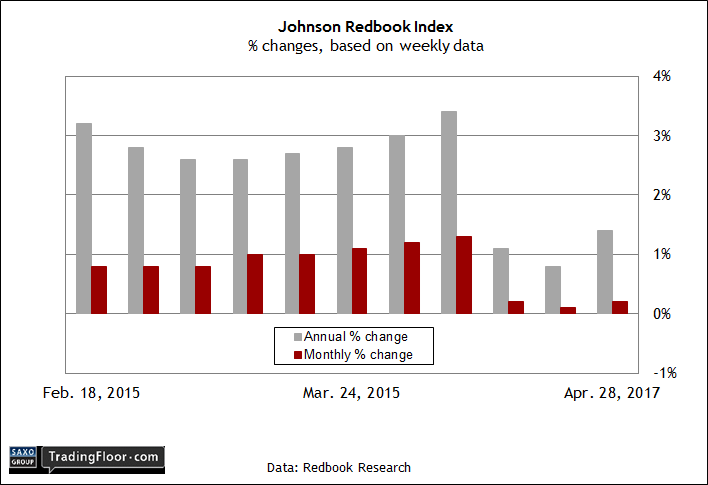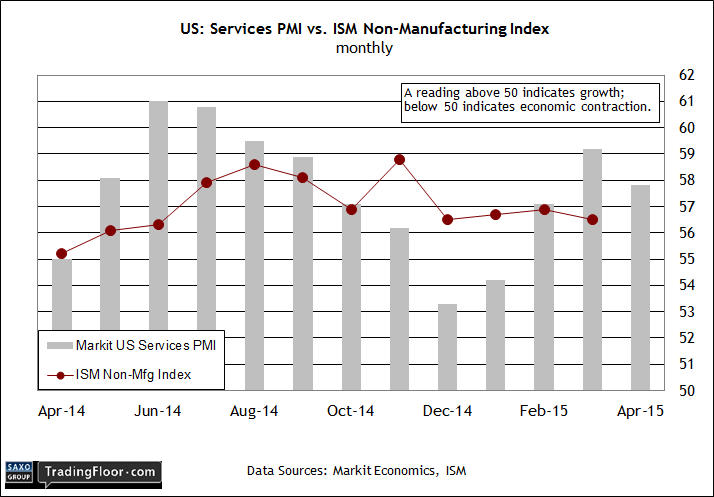The forecast that deflation risk is receding in Europe is on track for another dose of supporting evidence in today’s release on producer prices. Meanwhile, the case for a second-quarter rebound in the US is in focus again with the release of weekly store sales data via the Redbook Index and the April report for the ISM Non-Manufacturing Index.
Eurozone: Producer Price Index (09:00 GMT) The European Central Bank’s efforts to pull the Eurozone back from the deflation cliff is in focus again today with the monthly update of industrial prices. The previous release for February looks encouraging, and not a moment too soon. Deflation has been raging in this corner of the economy, with industrial prices sliding steadily for months. But there’s a cautious and somewhat compelling view that a mild degree of growth has finally returned to Europe, which includes a lessening of deflation risk. That’s been clear in recent numbers, including last week’s report on consumer prices for April. Today’s data on the Producer Price Index (PPI) for March will provide yet another test.
Economists are optimistic that the tide is turning, albeit slowly. Year-over-year PPI will continue to fall by 2.3% through the end of the first quarter, according to Econoday.com’s consensus forecast. But if the crowd’s right, PPI’s deflationary bite will soften for the second straight month.
On a monthly basis, the shift away from deflation is conspicuous. PPI in February posted a 0.5% rise, marking the first increase in five months and a sharp rebound from the 1.1% stumble in January.
“After having reached low levels in mid-January, longer-term inflation expectations in the euro area have recovered,” the ECB advised in last week's economic bulletin. “The decline observed over the previous two years has thus come to a halt.”
In that case, today’s PPI release should provide a fresh round of support for the central bank’s outlook.

US: Redbook Index (12:55 GMT) The search for signs of a second-quarter revival in economic activity after a sharp slowdown in the first quarter continues today with the weekly update of the Redbook Index, which measures store sales across the US. The numbers so far in April look relatively weak, however, and so the crowd will be keenly focused on how today’s report compares.
In last week’s release, sales inched higher, posting a slim 0.2% gain during the first three weeks of last month compared with the previous month, according to Redbook Research. The year-over-year change is stronger, but it’s still down substantially from the pace in previous months.
Broadly speaking, most analysts are still looking for an improvement in growth in the second quarter. The Atlanta Federal Reserve’s current estimate for GDP growth in the April-through-June period, for instance, is 0.8%. That’s up from the virtually flat 0.2% gain in the first quarter, but as revivals go the latest number looks fairly tepid.
The Blue Chip consensus view for the second quarter is considerably higher — in the low-3% range. But this source turned out to be far too optimistic for the first quarter. In short, the Atlanta Federal Reserve’s nowcast for weak growth remains a compelling counterpoint at the moment to the upbeat estimates found elsewhere.
Then again, if the second-quarter growth rate is due for upward revisions in the weeks ahead, perhaps we will see a clue in today’s Redbook release.

US: ISM Non-Manufacturing Index (14:00 GMT) The second quarter may be off to a mixed start, but the view from the services sector betrays few signs of trouble in its kick-off. The flash estimate of Markit’s US Services Purchasing Managers Index (PMI) for April dipped moderately to 57.8 from 59.2 in the previous month, but that still reflects a solid profile for this key corner of the US economy.
“The service sector enjoyed strong growth at the start of the second quarter, adding to evidence that the economy remains in good health,” Markit’s chief economist said last week. “Although the pace of expansion slowed compared to March, April saw the second-largest rise in business activity for seven months.”
Nonetheless, there's still widespread concern about macro momentum in the second quarter after the dismal start to the year. With GDP growth dipping to nearly stall speed in the first three months of 2015, the market will remain sensitive to any signs of weakness in the releases for the foreseeable future.
Today’s first look at ISM’s measure of the services industry isn’t expected to give the economy’s bears any new ammunition, however. Econoday.com projects that the index will remain unchanged at a healthy 56.5 for April. The revised April update for the services PMI (scheduled for release at 13:45 GMT) is on track for something similar via a fractional down-tick compared with last week's flash data.
Overall, the numbers on tap for today’s review of the services sector are expected to report a solid rate of growth. But with a mixed bag of data generally so far for April’s macro profile, today’s releases won’t convince the skeptics to dismiss the worry that the US economy is struggling to right itself after a disappointing first quarter.

Disclosure: Originally published at Saxo Bank TradingFloor.com
